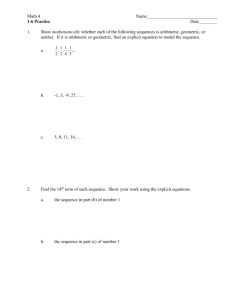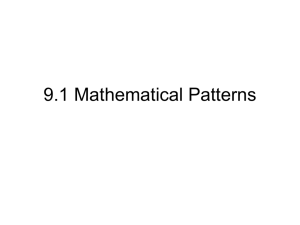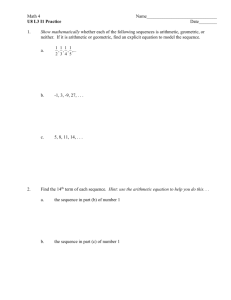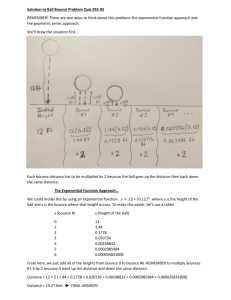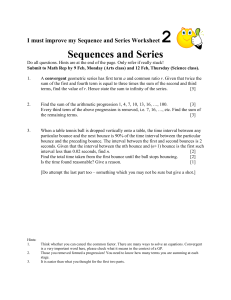On the Instability of the Lee-Wick Bounce Taotao Qiu 2011-06-21
advertisement
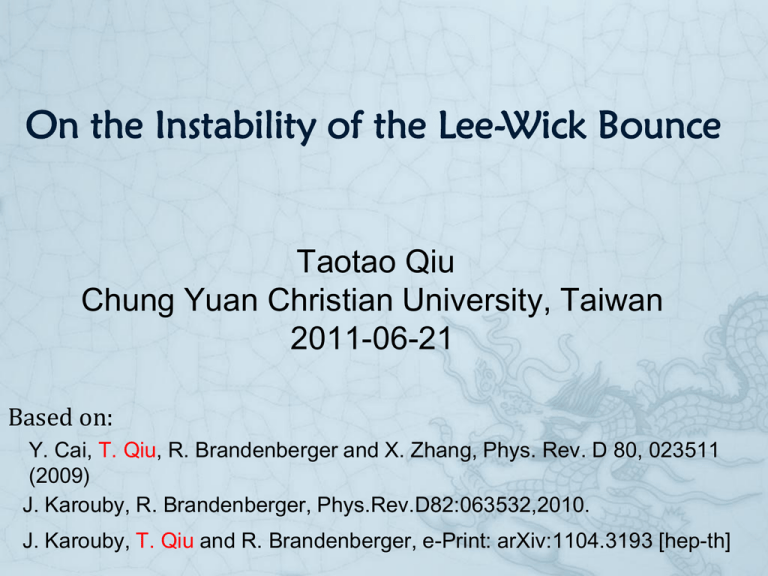
On the Instability of the Lee-Wick Bounce Taotao Qiu Chung Yuan Christian University, Taiwan 2011-06-21 Based on: Y. Cai, T. Qiu, R. Brandenberger and X. Zhang, Phys. Rev. D 80, 023511 (2009) J. Karouby, R. Brandenberger, Phys.Rev.D82:063532,2010. J. Karouby, T. Qiu and R. Brandenberger, e-Print: arXiv:1104.3193 [hep-th] The Early Universe Temperature fluctuations Variables for testing perturbations: Power spectrum Power spectrum: Spectral index: D. Larson et al. [WMAP collaboration], arXiv:1001.4635 [astro-ph.CO]. Inflation Definition: “Slow roll”: the Horizon problem the Flatness problem the unwanted relics problem Give rise to the right amount of perturbations The singularity problem The Alternatives of inflation Pre-big bang Scenario Ekpyrotic Scenario String gas/Hagedorn Scenario Non-local SFT Scenario Bouncing Scenario The basic idea of bounce contraction Formalism: Contraction: Bouncing Point: IR size with Low energy scale expansion Singularity problem avoided! Expansion: ( At the ) Neiborhood: In order to connect this process to the observable universe (radiation dominant, matter dominant, etc), w should come back to above -1 again! Y. Cai, T. Qiu, Y. Piao, M. Li and X. Zhang, JHEP 0710:071, 2007 The Zoo of Bounce models Bounce + Large field inflation Cai, Qiu, Brandenberger, Piao, Zhang, JCAP 0803: 013,2008. BOUNCE MODELS Radiation Bounce Brandenberger, Karouby, Qiu, in preparation. Bounce + Small field inflation Cai, Qiu, Xia, Zhang, . Phys.Rev.D79: 021303,2009. Lee-Wick Bounce Cai, Qiu, Brandenberger, Zhang, Phys.Rev.D80: 023511,2009. Holographic Bounce Cai, Xue, Brandenberger, Zhang, JCAP 0906: 037,2009. Others: Bouncing in Modified Gravity New Ekpyrotic model K-Bounce ………… Non-minimal coupling Bounce Qiu, Yang, JCAP 1011: 012, 2010; Qiu, Class.Quant.Grav.27: 215013, 2010. The Lee-Wick Bounce Model The Lagrangian: Or equivalently: Regular Higgs LW partner Y. Cai, T. Qiu, R. Brandenberger and X. Zhang, Phys. Rev. D 80, 023511 (2009) Equations of Motion Metric of space-time: Friedmann Equation: In addition, there are the coupled Klein-Gordon equations for and . The Field Evolution Contracting: dominates Freeze Oscillate Near the bounce: freezes still oscillates A bounce happens: Oscillate when the contribution of LW scalar to the energy density catches up to that of the normal scalar Expanding: dominates again Background Description of LW Matter Bounce Background parameters: Perturbations in LW Matter Bounce 1. Analytical Analysis: Perturbed Einstein Equations: In the matter-dominant era: with Near the bounce point: where Initial condition: Bunch-Davies vacuum Perturbations in LW Matter Bounce 1. Analytical Analysis: Before bounce: Matching condition: Power spectrum: After bounce: Perturbations in LW Matter Bounce 2. Numerical Calculation: Sketch plot of perturbation: Power spectrum and index: How does Bounce solve other cosmological problems? Horizon problem: the horizon in the far past in contracting phase is very large; Flatness problem: avoided if the spatial curvature at temperatures in the contracting phase comparable to the current temperature is not larger than the current spatial curvature; How does Bounce solve other cosmological problems? Trans-Planckian and Unwanted relics problem: If the energy density at the bounce point is given by the Grand Unification scale ( ), then and the wavelength of a perturbation mode is about Unwanted relics can also be avoided because of the low energy scale The Problem of LW matter bounce Radiation: Matter: Instability in presence of radiation in contracting phase! Adding the LW gauge partner The Lagrangian: Or equivalently: Expectation: have protect the bounce. U(1) symmetry breaking! (which is negative) cancel , in order to But can it succeed? J. Karouby, R. Brandenberger, Phys.Rev.D82:063532,2010. The Dynamics The energy density: Equations of motion: sourced by unsourced The reason of the difference is that we required mass of LW gauge field, while normal gauge field is massless! The solutions The energy density: and are undamping oscillating functions and hence depends on the unsourced solution the initial phase. and , hence depend on For example: If The solutions and Then and If will lose energy due to for positive c. and Then and will get energy due to for positive c. Even with only one Fourier mode excited, the average over all phases (angles) will have the total effect of energy transfer vanish! So the conclusion is that it is impossible to transfer energy from the gauge field to its LW partner, and bounce would not happen, unless severely fine-tuned! Our model Introducing interactions between scalar and gauge fields: Equations of motion: J. Karouby, T. Qiu and R. Brandenberger, e-Print: arXiv:1104.3193 [hep-th] Born Approximation Ref: http://en.wikipedia.org/wiki/Born_approximation For scalar fields: For vector field: with other components of vanishing. The Energy Momentum Tensor The energy density: The pressure: Direction-dependent! with Dynamics For ^(0) components: Equations: Solutions: For For Note: the vector field (radiation) is of first order! Dynamics For ^(1) components: Scalar fields: Equations: Solutions: For For Dynamics For ^(1) components: Gauge fields: Equations: Let Solutions: For For while is the solution with c=d=0. Dynamics For ^(2) components: Equations: Solutions: Or if we only care about their scalings: Scalings of Each Component For ^(0) components: Scalings of Each Component For ^(1) components: Scalings of Each Component For ^(2) components: Conditions for a bounce to happen 3 types of terms: positive definite, negative definite, indefinite energy densities of normal scalar and gauge field energy densities of the ghost scalar couplings among scalars and gauge field The basic condition for a bounce to happen: the negative definite terms scales more negative w.r.t. a(t), then grows faster! In the absence of coupling: impossible! (the radiation part will always grow faster than the scalars) In the presence of coupling: can be achieved by setting coupling coefficients c and d. Conditions for a bounce to happen Slow bounce: only solutions of before the bounce For slow bounce: For fast bounce: Fast bounce: both solutions of and before the bounce Results For the configuration which a single Fourier mode is excited: For For and and Results For the configuration which two Fourier modes are excited: For and So the conclusion is that for more than one Fourier modes excited, it is also difficult to get a bounce, and fine-tuning is also needed! Conclusions The Lee-Wick theory can give rise to a bounce, however naively the presence of radiation will prevent the bounce because of the larger negative scaling w.r.t. a(t). With the presence of LW partner of the gauge field, bounce needs severe fine-tuning of initial phase. With the coupling between gauge field and scalar, conditions for bounce derived for one Fourier mode, but for infinite modes fine-tuning also needed! Perturbations in inflationary cosmology Perturbed metric in conformal Newtonian gauge: Perturbation Equations for metric: where is the conformal Hubble parameter and prime denotes derivative w.r.t. The general solution is: where S and D are constants. Perturbations in inflationary cosmology For background with constant equation of state w: where Defining curvature perturbation: One have: where The solution for adiabatic perturbation is: and The spectrum: with index: For inflationary cosmology where invariant. the spectrum is scale The differences between perturbations in inflationary and bounce cosmologies 1.There is pre-evolution in contracting time, when horizon was crossed Inflationary cosmology bounce cosmology Note: the initial perturbation was still deep in horizon and can also can be seed for structure formation, so the structure formation problem can also be solved! The differences between perturbations in inflationary and bounce cosmologies 2. Evolutions of different stages are connected via matching conditions Hwang-Vishiniac (Deruelle-Mukhanov) matching conditions (in Conformal Newtonian Gauge): where denotes variable difference between (+) phase and (-) phase. According to this, we have: where + and – stands for expanding and contracting phases, and A and B are constants. J. c. Hwang and E. T. Vishniac, Astrophys. J. 382, 363 (1991); N. Deruelle and V. F. Mukhanov, Phys. Rev. D 52, 5549 (1995); R. Brandenberger and F. Finelli, JHEP 0111, 056 (2001). The differences between perturbations in inflationary and bounce cosmologies 3. Since in bounce cosmology, there can be no inflationary phase which redshifts all the pre-existing classical matter, thermodynamic generation of the perturbations is also possible! For example, see J. Magueijo and L. Pogosian, Phys. Rev. D 67, 043518 (2003) [arXiv:astro-ph/0211337]; J. Magueijo and P. Singh, Phys. Rev. D 76, 023510 (2007) [arXiv:astro-ph/0703566]. Matter Bounce Cosmology: Introduction Background Vacuum production Thermal production Perturbations in Matter Bounce (II): thermal production From perturbed Einstein Equation: We get the amplitude of Newtonian potential: where And the power spectrum at the Hubble radius crossing: where and Perturbations in Matter Bounce (II): thermal production Assuming that the fluctuations are generated in a holographic way: and corresponds to Gibbons-Hawking temperature: The spectrum: with where For matter bounce (w=0), one have and and a scale-invariant spectrum could be obtained. , Y. F. Cai, W. Xue, R. Brandenberger, X. m. Zhang, JCAP 0906:037,2009. Summary on bouncing cosmology Can solve the singularity problem as well as other problems that are encountered by Big Bang theory; Have different generation (vacuum and thermodynamical) and evolution mechanisms of perturbations from inflationary cosmology; Can give rise to scale-invariant power spectrum of primordial perturbations. What can inflation not do If the universe has a beginning before inflation, the beginning point will be geodesically incomplete where classical General Relativity cannot be implied. S.W. Hawking, G.F.R. Ellis, Cambridge University Press, Cambridge, 1973. Even there is no beginning and inflation is eternal to the past, there will also be singularities in the far past. Borde and Vilenkin, Phys.Rev.Lett.72,3305 (1994). As long as the universe go beyond Planckian scale, the Robustness of high energy effects are inevitable. J. Martin, and R.Brandenberger, Phys.Rev.D63:123501 (2001). Outline Preliminary: Bouncing Scenario As an Alternative of Inflation Perturbations of Bouncing Cosmology vs. Inflationary Cosmology Matter Bounce Precision Cosmology Beginning from the observational data: BBN,CMB(COBE) SN Big Bang Dark Energy WMAP, SDSS Concordance model: Others: such as PLANCK etc. LCDM


